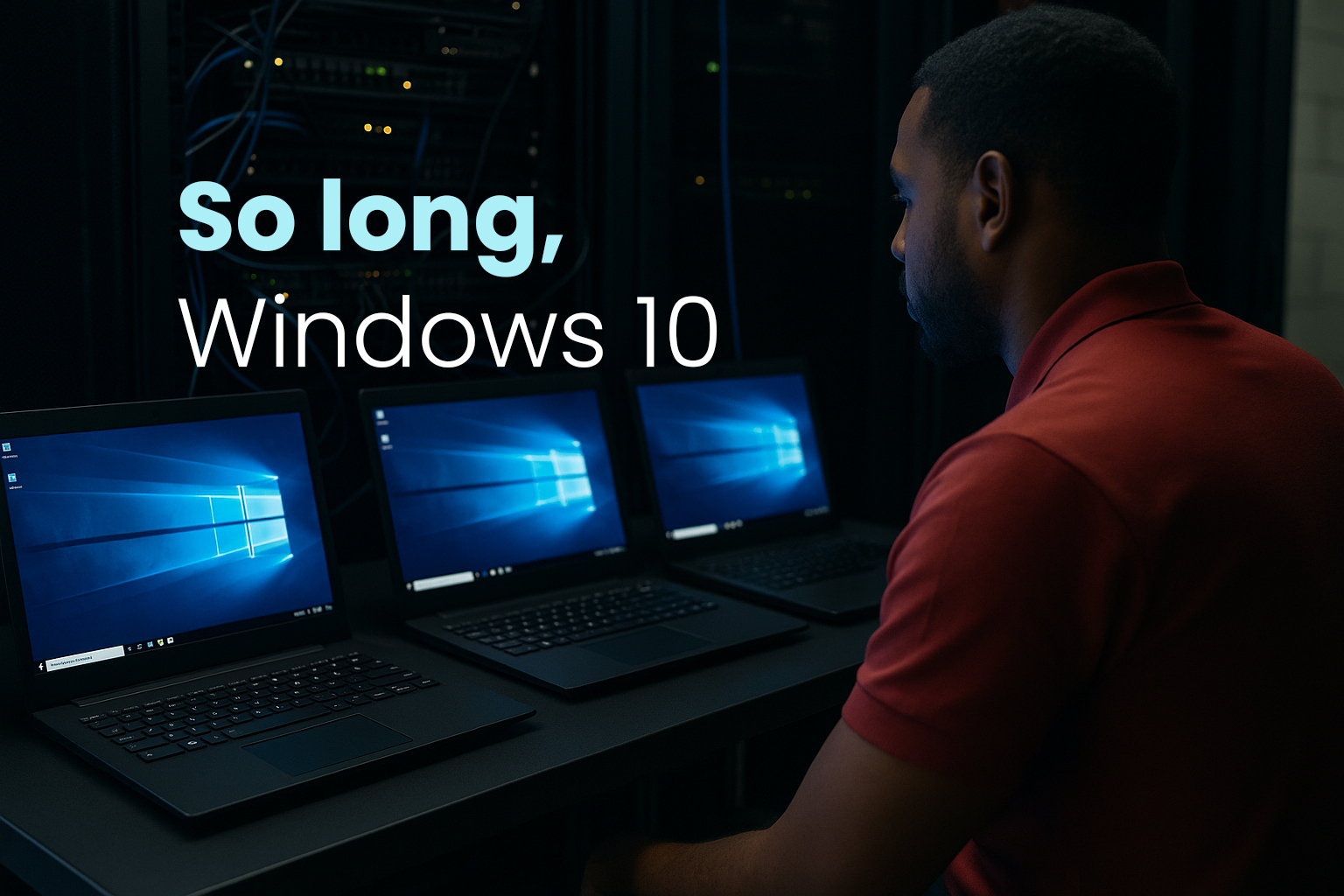Windows 10 End of Support in October: What K‑12 IT Leaders Need to Do Now
October 14, 2025 is the last day Microsoft will provide free security updates for Windows 10, version 22H2. This applies to Home, Pro, and Education editions. Version 22H2 is the final Windows 10 release. (Source: Microsoft Learn)
After that date, districts that keep any Windows 10 devices in service face three choices: upgrade to Windows 11, pay for Extended Security Updates, or retire and replace the devices. This guide outlines the practical implications for U.S. school districts and a concrete action plan you can execute during FY25‑26.
What changes on October 14, 2025
- No more free security or quality updates for Windows 10. PCs will continue to run, but unpatched vulnerabilities will accumulate. (Source: Microsoft)
- Extended Security Updates (ESU) are available if you must keep devices on Windows 10. For organizations, ESU is $61 per device for Year 1, and the price doubles each subsequent year for up to three years. Devices that connect to a Windows 365 Cloud PC are entitled to ESU at no additional cost while the subscription is active. Individuals on Windows 10 Home can purchase a $30 one‑year ESU. (Source: Microsoft Learn)
- Microsoft 365 Apps on Windows 10 will receive security updates through October 10, 2028, but new feature updates stop in August 2026. Expect a gradually “frozen” feature set on Windows 10 while security fixes continue. (Source: Windows Blog)
Why this matters for K‑12
- Student Testing
- Many assessment vendors key OS support to the upstream provider. Cambium Assessment states it ends support one full school year after the OS vendor ends support. Pearson’s TestNav publishes a rolling support matrix districts must meet each year. If you remain on Windows 10 without ESU or beyond vendor windows, you risk high‑stakes test day failures. (Sources: Cambium AST Guides / Pearson Assessment Support)
- For College Board’s Bluebook app, Windows 10 is allowed only until fall 2026, and the organization recommends moving to Windows 11 before Microsoft’s October 2025 deadline. (Source: College Board Bluebook)
- Cybersecurity risk and compliance
- CISA’s baseline guidance is clear: keep operating systems fully supported and up to date. Running an unsupported OS increases exposure to ransomware and other threats, and may run counter to grant program best practices that call for ending use of unsupported software on internet‑accessible systems. (Sources: CISA / Texas DIR)
- Windows 11 Hardware Requirements
- A subset of older PCs cannot upgrade due to requirements like TPM 2.0, UEFI with Secure Boot, and CPU compatibility. Plan for testing and inventory now so there are no surprises. (Sources: Microsoft Support / Microsoft Learn)
A 90‑day plan most districts can follow
- Inventory and readiness assessment
- Use PC Health Check for spot checks and your management stack for fleet‑wide reporting. Intune and Configuration Manager include Windows 11 readiness dashboards to flag TPM, Secure Boot, and CPU blockers. (Sources: Microsoft Support / Microsoft Learn)
- Segment your fleet
Create four groups and decide the path for each- Ready for Windows 11. Schedule an in‑place upgrade after validating key apps and drivers. (Source: Microsoft Support)
- Upgradeable with configuration. Where hardware supports TPM 2.0 and UEFI, enable required firmware settings, then upgrade. (Source: Microsoft Support)
- Requires ESU. Mission‑critical devices that cannot upgrade in time. Budget $61 per device for Year 1 and plan to exit ESU within three years. Education customers can leverage $1, $2, $4 pricing tiers for Windows 10 ESU under Microsoft’s education offer. (Source: Microsoft Learn / Microsoft)
- Replace. Devices that cannot meet Windows 11 requirements or that vendors will not support for testing in 2026 (Source: College Board Bluebook)
- Align with assessment and academic calendars
- Map state testing windows, interim assessments, and Bluebook/SAT dates against your OS rollout to avoid disruptions. Use vendor OS support pages to verify the versions you plan to run in spring 2026. (Sources: Pearson Assessment Support / College Board Bluebook)
- Budgeting and purchasing
- ESU for organizations: $61 per device for Year 1 via volume licensing, increasing each year, up to three years. Windows 365 endpoints are entitled to ESU with an active subscription. (Source: Microsoft Learn)
- Education ESU pricing: $1 in Year 1, $2 in Year 2, $4 in Year 3 for eligible K‑12 and higher‑ed customers. (Source: Microsoft)
- Avoid relying on the consumer ESU for district‑owned fleets. That $30 offer targets Windows 10 Home devices and does not address enterprise management needs. (Source: Microsoft Learn)
- Communicate early with schools
- Share simple messages: why upgrades are required, which buildings are scheduled when, and what users should expect on first login. Reference CISA guidance on keeping systems supported to frame the security rationale. (Source: CISA)
- Validate critical apps and peripherals
- Pilot Windows 11 images with your SIS, time and attendance, driver software, secure testing apps, and accessibility tools. Confirm vendor support on Windows 11 for spring 2026. (Source: College Board Bluebook / Pearson Assessment Support)
Key details IT leaders ask about
What exactly are Windows 11 minimums I should check?
At a minimum: 64‑bit CPU with 2 or more cores at 1 GHz, 4 GB RAM, 64 GB storage, UEFI with Secure Boot, and TPM 2.0. Microsoft maintains the supported CPU lists by vendor. (Sources: Microsoft / Microsoft Support / Microsoft Learn)
How long can we safely stay on Microsoft 365 Apps if some PCs remain on Windows 10?
Microsoft will deliver security updates to Microsoft 365 Apps on Windows 10 through October 10, 2028. New features stop arriving on Windows 10 beginning August 2026, so plan accordingly for feature parity. (Source: Windows Blog)
Do testing vendors really drop OS support right away?
Policies vary. Cambium’s plan ends support one school year after the OS vendor stops support, while Pearson publishes annually updated TestNav requirements. Always verify the specific version you intend to run for the upcoming school year. (Source: Cambium AST Guides / Pearson Assessment Support)
A quick note about Touchpoint hardware
Touchpoint SmartClocks run Windows 10 IoT Enterprise LTSC, a long‑term servicing edition with its own lifecycle that continues receiving updates beyond October 2025. For example, Windows 10 IoT Enterprise LTSC 2021 is supported through January 13, 2032, and LTSC 2019 through January 9, 2029. This means Touchpoint SmartClocks are unaffected by the October 2025 Windows 10 end of support, which gives districts confidence in relying on Touchpoint hardware during their broader Windows migration. (Source: Microsoft Learn). Any Touchpoint customers with devices running older versions like LTSC 2016 should contact Touchpoint support to get software updates or to upgrade to newer SmartClock models.
One‑page checklist you can copy into your project plan
- Pull a Windows 11 readiness report from Intune or ConfigMgr. Tag devices by “Upgradeable,” “Config change needed,” “ESU,” and “Replace.” (Source: Microsoft Learn)
- Confirm test vendor OS support for spring 2026, including Bluebook if applicable. (Source: College Board Bluebook / Pearson Assessment Support
- Decide where ESU makes sense, secure purchasing approvals, and enroll eligible devices. Use the education ESU pricing if your district qualifies. (Source: Microsoft Learn)
- Stage Windows 11 pilots in each school level and validate core apps, drivers, and peripherals. (Source: Microsoft Support)
- Publish building‑by‑building schedules and a “what to expect on first login” guide. Anchor your message in CISA’s “keep systems supported” best practice. (Source: CISA)
Sources
- Microsoft lifecycle and end‑of‑support details for Windows 10. Microsoft Learn
- Extended Security Updates program and pricing for organizations and individuals, plus Windows 365 ESU entitlement. Microsoft Learn
- Microsoft 365 Apps on Windows 10: security updates through Oct 10, 2028; feature updates stop in Aug 2026. Windows Blog
- Windows 11 minimum system requirements and supported processors. Microsoft
- Testing vendor OS policies: Cambium OS support plan; Pearson TestNav system requirements. Cambium AST Guides
- College Board Bluebook Windows requirements. College Board Bluebook
- CISA guidance on keeping operating systems supported and up to date. CISA+1
Interested in learning more about Touchpoint's reliable, headache-free SmartClocks for school districts?
👉 Click here to request more info or a quote!
Touchpoint—time tracking made simple, secure, and compliant.
It's about time.

Rand Habegger
Rand Habegger is a seasoned veteran of EdTech, with nearly two decades' experience helping unsung underdogs in school district offices identify solutions to unique K-12 problems. When he's not helping educators discover breakthroughs, you might find him snowboarding with his kids, performing in a local music theater production (also with his kids), or thoughtfully sipping a vanilla cream soda he hasn't ranked yet.

